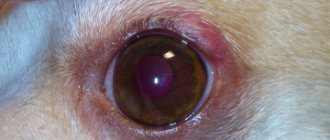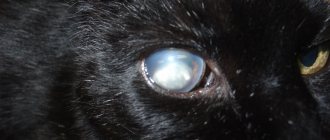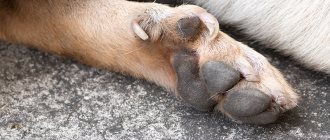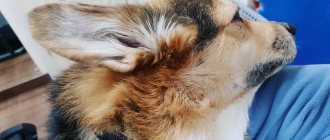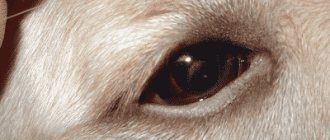Causes of eye injuries in dogs
Experienced dog breeders and veterinary ophthalmologists most often encounter the following causes of visual injuries in four-legged friends:
- Fights. Showdowns with relatives, fights with eternal opponents and bully cats often end in scratches and deep damage not only to soft tissues, but also to the optical system of the eye.
- In the winter season, especially on holidays, there is an increase in cases of seeking veterinary help due to injury to a pet by foreign objects (firecrackers, fireworks, bottle caps).
- The dog often gets injured while walking through tall grass, bushes, and dense forest. Representatives of hunting breeds, excitedly pursuing their prey, stumble upon twigs, hard grass, and plant thorns. Working dogs, following a scent, are injured when large dust particles or sand enter their visual organs.
- Chemical injuries are associated with the ingress of various types of reagents (acids, alkalis, organic solvents, etc.) into the organs of vision.
- Thermal damage is possible if your pet is too curious about the source of an open fire.
Not only hunting and working dog breeds are at risk, but also representatives of fighting breeds, and simply active and active individuals. Due to the peculiarities of the anatomical structure of the head, animals with a brachycephalic skull structure are mostly susceptible to various types of ophthalmological injuries.
We recommend reading about purulent wounds in dogs. You will learn about how to treat a wound at home, treatment of inflammatory formation in stages (cleansing, drainage, antibiotics, etc.). And here is more information about what and how to treat a wound (torn, weeping, purulent) on a dog.
The dog is bleeding
- general information
- How to perform an inspection
- What actions should you take?
Dog's eye is bleeding
The dog has blood on his ear
- general information
- How to perform an inspection
- What actions should you take?
The dog has a nosebleed
- general information
- How to perform an inspection
- What actions should you take?
The dog has blood in his mouth
- general information
- How to perform an inspection
- What actions should you take?
The dog has blood on his neck
- general information
- How to perform an inspection
- What actions should you take?
The dog has blood on his paw
- general information
- How to perform an inspection
- What actions should you take?
The dog has blood on its skin
- general information
- How to perform an inspection
- What actions should you take?
The dog has blood in the anus area
- general information
- How to perform an inspection
- What actions should you take?
Types of damage
In veterinary practice, the following types of eye injuries in pets are distinguished:
- Damage to the eyelids. Such injuries can be through or non-through. Mechanical damage to the lower or upper eyelid is often accompanied by bleeding. The optical system of the eye is not impaired in such pathologies. The animal experiences profuse lacrimation immediately after injury.
- Corneal injury . Damage can be non-penetrating or penetrating. The greatest danger is posed by deep injuries to the cornea, often leading to loss of visual function. The introduction of sharp objects into the cornea is fraught with the penetration of pathogenic microorganisms into the eye tissue and the development of an inflammatory reaction.
Eye injury from a cat's claw
- Eye contusion . Similar injuries occur when kicked, hit by a stick, or when the animal bumps into a hard object while running. The damage is accompanied by an increase in intraocular pressure, displacement and rupture of the internal structures of the organs of vision. In severe cases, the eyeball falls out of the socket. Contusion can lead to damage to the lens, which can lead to blindness in your pet.
Veterinary ophthalmologists distinguish between simple, complex and complicated injuries. The owner of the animal should understand that even seemingly mild ophthalmological damage can cause vision loss.
Symptoms
The cornea of the eye contains many nerve endings, so if it is damaged, the dog experiences discomfort and pain. The animal becomes restless and often rubs the damaged eye with its paw or rubs it against objects. Symptoms indicating injury to the cornea also include:
- profuse lacrimation;
- redness of the conjunctiva of the eye;
- clouding of the cornea in the damaged area;
- spasm of the eyelids (blepharospasm);
- photophobia (the animal turns away from the light source, squints its eyes, closes its eyes).
Attention! It is strictly prohibited to independently use any treatment methods, including removing a foreign object stuck in the cornea - such manipulations can threaten to rupture the cornea and damage the integrity of the eyeball. But it is possible and necessary to provide first aid to an injured pet, after which the dog must be taken to a veterinary clinic as quickly as possible.
Symptoms of the problem
Veterinary experts recommend paying attention to the following signs of eye injury in pets:
- Eyeball loss
Redness of the eyelids. The animal is worried and rubs its eyes with its paws. Damage may be accompanied by bleeding. - Swelling or swelling of the eyelids. Often there is complete closure of the upper and lower eyelids.
- Tearing. In case of injury, as a rule, the owner discovers a profuse secretion of tears from one eye.
- Photophobia. Injured tissues are easily irritated by bright light. The pet squints and tries to hide in a dark place.
- Purulent discharge from a wounded eye. The symptom is caused by the ingress of pathogenic microflora and the development of inflammation.
- Eye enlargement, protrusion. In severe cases, the owner may experience eyeball loss.
- Cloudiness of the cornea.
- Change in eye color.
- Lethargy, loss of appetite or complete refusal to eat.
The dog has discharge
- general information
- How to perform an inspection
- What actions should you take?
Dog has discharge from eye
Dog has ear discharge
- general information
- How to perform an inspection
- What actions should you take?
Dog has nasal discharge
- general information
- How to perform an inspection
- What actions should you take?
Dog has skin discharge
- general information
- How to perform an inspection
- What actions should you take?
Dog has anal discharge
- general information
- How to perform an inspection
- What actions should you take?
Diagnosis of the condition of the cornea and other parts of the eye
If even slight damage to the pet’s organ of vision is detected, the owner should not hesitate to visit a specialized institution. In addition to the physical examination, the ophthalmologist will conduct instrumental diagnostic methods - ophthalmoscopy, ultrasound.
In some cases, the veterinarian resorts to a test sample with a fluorescent substance to identify the location and extent of damage to the cornea. In some cases, intraocular pressure is measured.
Special means of ophthalmological examination are carried out after preliminary sedation of the animal. Special research methods make it possible to identify deep damage to the ocular structures - prolapse of the iris, dislocations and subluxations of the lens, disruption of the hydrodynamics of the eye.
If the organs of vision are damaged, it is best to show the animal to a specialist - a veterinary ophthalmologist. The doctor will not only conduct special research methods, but also, if necessary, provide surgical treatment for the problem that has arisen.
The dog has eye problems
- General information. How to perform an inspection
- What actions should you take?
The dog's eyes are red
The dog has a hemorrhage in the eye
- General information. How to perform an inspection
- What actions should you take?
The dog has “bulging eyes”
- general information
- How to perform an inspection
- What actions should you take?
The dog squints
- General information. How to perform an inspection
- What actions should you take?
The dog's pupils are dilated
- General information. How to perform an inspection
- What actions should you take?
The dog's pupils are constricted
- General information. How to perform an inspection
- What actions should you take?
Dog's pupils do not respond well to light
- General information. How to perform an inspection
- What actions should you take?
The dog has dark spots on the iris
- general information
- How to perform an inspection
- What actions should you take?
The dog's third eyelid is abnormal
- General information. How to perform an inspection
- What actions should you take?
The dog has a stye
- general information
- How to perform an inspection
- What actions should you take?
How is the treatment carried out?
Treatment for eye trauma in dogs is primarily determined by the severity of the injury. As a rule, injuries to the organs of vision are accompanied by painful sensations in the animal. To reduce pain, analgesics and antispasmodics are prescribed - Baralgin, Spazgan, No-shpu. A 2% solution of novocaine applied topically helps relieve pain.
Eye drops should only be used after examination by a veterinary ophthalmologist and on his recommendation. To relieve inflammation and swelling in veterinary practice, drops are used - Tsiprovet, Interpan, Tobrex. In some cases, an ophthalmologist may prescribe eye ointments.
If a foreign body is detected, it is removed with a special spear or grooved chisel. The manipulation is carried out after preliminary sedation of the animal and epibulbar anesthesia. If a pet is found to have a corneal wound with pinching of the iris, a veterinarian performs surgical removal of fibrin deposits and suturing of the iris.
If necessary, the surgeon seals the cornea. If damage to the lens is detected, it is removed.
An injury that is accompanied by dislocation of the eyeball requires abundant hydration until the problem is promptly resolved. After repositioning the eyeball, the animal is prescribed a course of antibacterial drugs and glucocorticoids.
a) After removal of the eyeball; b) After tarsorrhaphy
In some cases, the ophthalmologist resorts to tarsorrhaphy - a temporary surgical closure of the cornea using an apron formed from the third eyelid. Full or partial eyelid suturing is used to protect the injured eye.
In cases of serious injury associated with the risk of sepsis, a veterinary ophthalmic surgeon resorts to complete removal of the eyeball.
For information on treating eye injuries in dogs, watch this video:
Dog after injury
Mechanical or chemical damage to the eyes in pets requires some care after initial treatment or surgery. First of all, it is necessary to take measures to prevent self-injury. Dogs can scratch the damaged organ with their paws and thereby worsen the situation. Veterinary experts recommend that owners wear a special protective collar on their pet during treatment and after surgery.
The animal is usually prescribed broad-spectrum antibiotics - Cobactan, Baytril, Sinulox, Enrofloxacin, Cephalexin, etc. Glucocorticosteroids - Prednisolone, Dexamethasone - help reduce the inflammatory reaction.
Is full recovery possible?
Owners are often concerned about the possibility of complete restoration of visual function in an animal after an ophthalmic injury. The dog’s recovery largely depends on the nature of the injury received, the degree of damage to the optical apparatus of the eye, the timeliness of seeking help, and proper treatment (including surgery).
Can an animal live with one eye?
Severe injury in some cases requires removal of the eyeball. The animal adapts to physical disabilities over time. The first time after surgery, the pet may have difficulty navigating in an unfamiliar environment and bump into objects. After a few months, the dog adapts; removal of one eye does not affect the quality of life. In addition, the animal has a well-developed sense of smell and good hearing, which help them navigate the world around them.
We recommend reading about traumatic brain injury in dogs. You will learn about the causes and types of traumatic brain injury in dogs, symptoms, consequences for the animal, examination and treatment by a veterinarian. Find out more about stroke in dogs here.
Eye injury is a common ophthalmic problem in dogs. Injuries occur when a foreign body enters the organs of vision, when the animal bumps into foreign objects, or as a result of a blow. Even seemingly minor injuries require a detailed examination by a veterinary ophthalmologist. In order to preserve the visual function of a pet, surgical intervention is often necessary.
The dog has a neoplasm
- general information
- How to perform an inspection
- What actions should you take?
The dog has a tumor on its face
A dog has a tumor on his eyelid
- general information
- How to perform an inspection
- What actions should you take?
The dog has a tumor on the third eyelid
- general information
- How to conduct an inspection. What actions should you take?
The dog has a tumor on his ear
- general information
- How to perform an inspection
- What actions should you take?
The dog has a tumor on his nose
- General information. How to perform an inspection
- What actions should you take?
The dog has a tumor near his mouth
- General information. How to perform an inspection
- What actions should you take?
The dog has a tumor on the skin
- General information. How to perform an inspection
- What actions should you take?
The dog has a tumor under his arm
- General information. How to perform an inspection
- What actions should you take?
The dog has a tumor in the groin
- general information
- How to perform an inspection
- What actions should you take?
The dog has a tumor on his paw
- general information
- How to perform an inspection
- What actions should you take?

